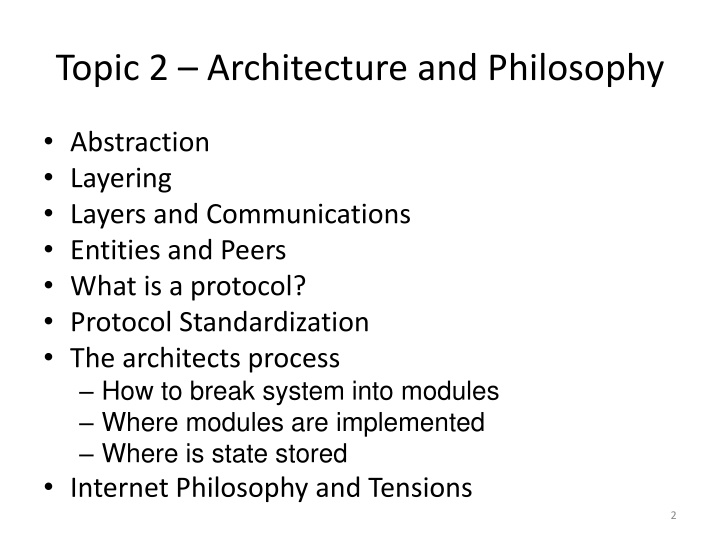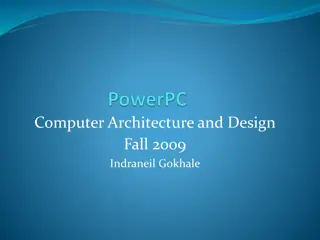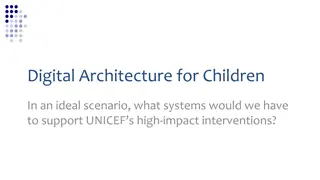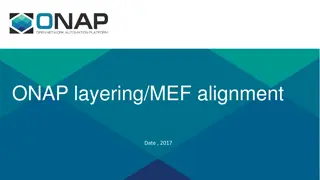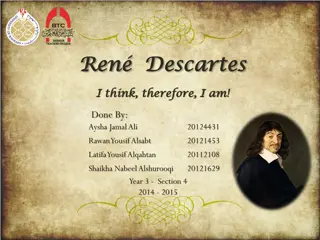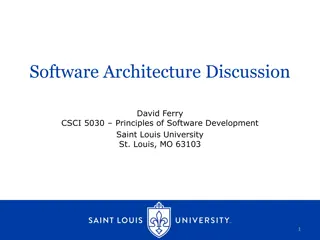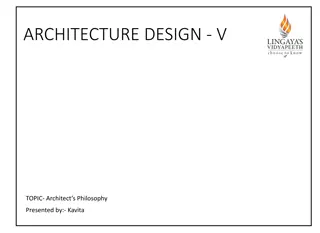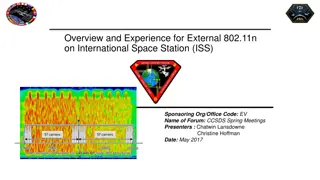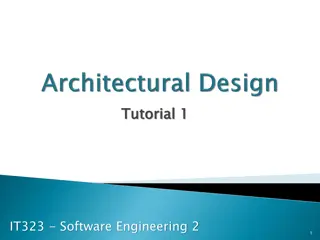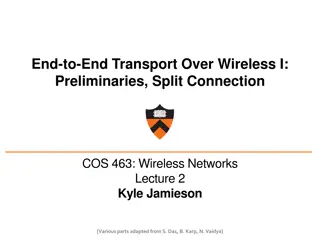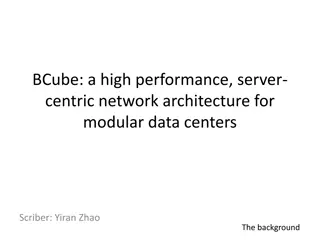System Modularity and Layering in Architecture and Philosophy
Explore the concepts of abstraction, layering, and protocol in computer systems. Learn how to break down systems into modules, where state is stored, and the importance of standardization. Delve into the implications of modularity in computer and network systems, highlighting the balance between flexibility and performance.
Download Presentation

Please find below an Image/Link to download the presentation.
The content on the website is provided AS IS for your information and personal use only. It may not be sold, licensed, or shared on other websites without obtaining consent from the author.If you encounter any issues during the download, it is possible that the publisher has removed the file from their server.
You are allowed to download the files provided on this website for personal or commercial use, subject to the condition that they are used lawfully. All files are the property of their respective owners.
The content on the website is provided AS IS for your information and personal use only. It may not be sold, licensed, or shared on other websites without obtaining consent from the author.
E N D
Presentation Transcript
Topic 2 Architecture and Philosophy Abstraction Layering Layers and Communications Entities and Peers What is a protocol? Protocol Standardization The architects process How to break system into modules Where modules are implemented Where is state stored Internet Philosophy and Tensions 2
Abstraction Concept A mechanism for breaking down a problem what not how eg Specification versus implementation eg Modules in programs Allows replacement of implementations without affecting system behavior Vertical versus Horizontal Vertical what happens in a box How does it attach to the network? Horizontal the communications paths running through the system Hint:paths are build on top of ( layered over ) other paths 3
Computer System Modularity Partition system into modules & abstractions: Well-defined interfaces give flexibility Hides implementation - can be freely changed Extend functionality of system by adding new modules E.g., libraries encapsulating set of functionality E.g., programming language + compiler abstracts away how the particular CPU works 4
Computer System Modularity (cntd) Well-defined interfaces hide information Isolate assumptions Present high-level abstractions But can impair performance! Ease of implementation vs worse performance 5
Network System Modularity Like software modularity, but: Implementation is distributed across many machines (routers and hosts) Must decide: How to break system into modules Layering Where modules are implemented End-to-End Principle Where state is stored Fate-sharing 6
Layering Concept A restricted form of abstraction: system functions are divided into layers, one built upon another Often called a stack; but not a data structure! thoughts speaking 1 words speaking 2 phonemes speaking 3 7 KHz analog voice D/A, A/D 8 K 12 bit samples per sec companding 8 KByte per sec stream multiplexing Framed Byte Stream framing Bitstream modulation 7 Analog signal
Layers and Communications Interaction only between adjacent layers layer n uses services provided by layer n-1 layer n provides service to layer n+1 Bottom layer is physical media Top layer is application n + 1 layer n layer n - 1 layer 8
Entities and Peers Entity a thing (an independent existence) Entities interact with the layers above and below Entities communicate with peer entities same level but different place (eg different person, different box, different host) Communications between peers is supported by entities at the lower layers 4 4 3 3 2 2 1 1 9
Entities and Peers Entities usually do something useful Encryption Error correction Reliable Delivery Nothing at all is also reasonable Not all communications is end-to-end Examples for things in the middle IP Router Mobile Phone Cell Tower Person translating French to English 4 4 3 3 2 2 2 10 1 1 1 1
Layering and Embedding In Computer Networks we often see higher-layer information embedded within lower-layer information Such embedding can be considered a form of layering Higher layer information is generated by stripping off headers and trailers of the current layer eg an IP entity only looks at the IP headers BUT embedding is not the only form of layering H T T P d a t a ( p a y l o a d ) H T T P h e a d e r Layering is to help understand a communications system NOT determine implementation strategy T C P h e a d e r T C P p a y l o a d I P h e a d e r I P p a y l o a d Ethernet header p a c k e t c h e c k s u m Ethernet payload 11
Example Embedding (also called Encapsulation) source message M application transport network link physical segment Ht Ht M datagram Hn Hn Hn Ht Ht M frame Hl M link physical switch destination network link physical Hn Ht M Hl Hn Ht M Hn Ht M application transport network link physical M Ht M Hn Ht M router Hl Hn Ht M 12
Internet protocol stack versus OSI Reference Model Presentation Application Transport Reference Data Link Physical Network Session Model OSI code-group using 8B/10B block coding scheme CODING: Each byte encoded into a 10 bit MODULATION: Digital electrical signal converted to analogue optical signal and transmitted on fibre FRAMING: Ethernet payload consists of individual octets ...0010101011110010110100001110001010101001... Ethernet header ...110100100101010100110101110011... ... Ethernet payload 1 0 1 header header TCP IP ...GET http://www.google.co.uk 1 0 1 0 TCP payload IP payload 0 0 c h e c k s u m p a c k e t 1 ... Application Transport Data Link Physical Network Protocol Internet stack 13
ISO/OSI reference model presentation: allow applications to interpret meaning of data, e.g., encryption, compression, machine- specific conventions session: synchronization, checkpointing, recovery of data exchange Internet stack missing these layers! these services, if needed, must be implemented in application application presentation session transport network link physical 14
What is a protocol? human protocols: what s the time? I have a question introductions network protocols: machines rather than humans all communication activity in Internet governed by protocols specific msgs sent specific actions taken when msgs received, or other events protocols define format, order of msgs sent and received among network entities, and actions taken on msg transmission, receipt 15
What is a protocol? a human protocol and a computer network protocol: Hi TCP connection request Hi TCP connection response Got the time? 2:00 GET http://www.cl.cam.ac.uk/index.html <file> time Q: Other human protocols? 16
Protocol Standardization All hosts must follow same protocol Very small modifications can make a big difference Or prevent it from working altogether This is why we have standards Can have multiple implementations of protocol Internet Engineering Task Force (IETF) Based on working groups that focus on specific issues Produces Request For Comments (RFCs) IETF Web site is http://www.ietf.org RFCs archived at http://www.rfc-editor.org 17
So many Standards Problem Many different packet-switching networks Each with its own Protocol Only nodes on the same network could communicate 18
INTERnet Solution Gateways 19
Internet Design Goals (Clark 88) Connect existing networks Robust in face of failures Support multiple types of delivery services Accommodate a variety of networks Allow distributed management Easy host attachment Cost effective Allow resource accountability 20
Real Goals Internet Motto We reject kings , presidents, and voting. We believe in rough consensus and running code. David Clark Build something that works! Connect existing networks Robust in face of failures Support multiple types of delivery services Accommodate a variety of networks Allow distributed management Easy host attachment Cost effective Allow resource accountability 21
In the context of the Internet Applications built on Reliable (or unreliable) transport built on Best-effort global packet delivery built on Best-effort local packet delivery built on Physical transfer of bits 22
Three Observations Each layer: Depends on layer below Supports layer above Independent of others Multiple versions in layer Interfaces differ somewhat Components pick which lower-level protocol to use But only one IP layer Unifying protocol 23 23
Layering Crucial to Internets Success Reuse Hides underlying detail Innovation at each level can proceed in parallel Pursued by very different communities 24 24
What are some of the drawbacks of protocols and layering? 25
Drawbacks of Layering Layer N may duplicate lower layer functionality e.g., error recovery to retransmit lost data Information hiding may hurt performance e.g., packet loss due to corruption vs. congestion Headers start to get really big e.g., typical TCP+IP+Ethernet is 54 bytes Layer violations when the gains too great to resist e.g., TCP-over-wireless Layer violations when network doesn t trust ends e.g., firewalls 26
Placing Network Functionality Hugely influential paper: End-to-End Arguments in System Design by Saltzer, Reed, and Clark ( 84) articulated as the End-to-End Principle (E2E) Endless debate over what it means Everyone cites it as supporting their position (regardless of the position!) 27
Basic Observation Some application requirements can only be correctly implemented end-to-end reliability, security, etc. Implementing these in the network is hard every step along the way must be fail proof Hosts Can satisfy the requirement without network s help Will/must do so, since they can t rely on the network 28
Example: Reliable File Transfer Host A Host B Appl. Appl. OS OS OK Solution 1: make each step reliable, and string them together to make reliable end-to- end process Solution 2: end-to-end check and retry 29
Discussion Solution 1 is incomplete What happens if any network element misbehaves? Receiver has to do the check anyway! Solution 2 is complete Full functionality can be entirely implemented at application layer with no need for reliability from lower layers Is there any need to implement reliability at lower layers? 30
Summary of End-to-End Principle Implementing functionality (e.g., reliability) in the network Doesn t reduce host implementation complexity Does increase network complexity Probably increases delay and overhead on all applications even if they don t need the functionality (e.g. VoIP) However, implementing in the network can improve performance in some cases e.g., consider a very lossy link 31
Only-if-Sufficient Interpretation Don t implement a function at the lower levels of the system unless it can be completely implemented at this level Unless you can relieve the burden from hosts, don t bother 32
Only-if-Necessary Interpretation Don t implement anything in the network that can be implemented correctly by the hosts Make network layer absolutely minimal This E2E interpretation trumps performance issues Increases flexibility, since lower layers stay simple 33
Only-if-Useful Interpretation If hosts can implement functionality correctly, implement it in a lower layer only as a performance enhancement But do so only if it does not impose burden on applications that do not require that functionality 34
We have some tools: Abstraction Layering Layers and Communications Entities and Peers Protocol as motivation Examples of the architects process Internet Philosophy and Tensions 35
Distributing Layers Across Network Layers are simple if only on a single machine Just stack of modules interacting with those above/below But we need to implement layers across machines Hosts Routers (switches) What gets implemented where? 36
What Gets Implemented on Host? Bits arrive on wire, must make it up to application Therefore, all layers must exist at the host source / destination application transport network link physical M Ht M Hn Ht M Hl Hn Ht M 37
What Gets Implemented on a Router? network link physical Hn Ht M Bits arrive on wire Physical layer necessary Hl Hn Ht M Hn Ht M Packets must be delivered to next-hop Datalink layer necessary router Routers participate in global delivery Network layer necessary Routers don t support reliable delivery Transport layer (and above) not supported 38
What Gets Implemented on Switches? Switches do what routers do, except they don t participate in global delivery, just local delivery They only need to support Physical and Datalink Don t need to support Network layer Won t focus on the router/switch distinction Almost all boxes support network layer these days Routers have switches but switches do not have routers link Hl Hn Ht M physical 39 switch
The Internet Hourglass Applications SMTP HTTP DNS NTP Transport TCP UDP Waist IP IP Data Link Ethernet SONET 802.11 Physical The Hourglass Model Copper Fiber Radio There is just one network-layer protocol, IP. The narrow waist facilitates interoperability. 40
Alternative to Standardization? Have one implementation used by everyone Open-source projects Which has had more impact, Linux or POSIX? Or just sole-sourced implementation Skype, many P2P implementations, etc. 41
A Multitude of Apps Problem SSH NFS HTTP Skype Application Coaxial cable Fiber optic Radio Transmission Media Re-implement every application for every technology? No! But how does the Internet design avoid this? 42
Solution: Intermediate Layers Introduce intermediate layers that provide set of abstractions for various network functionality and technologies A new app/media implemented only once Variation on add another level of indirection SSH NFS HTTP Skype Application Intermediate layers Coaxial cable Fiber optic Packet radio Transmission Media 43
